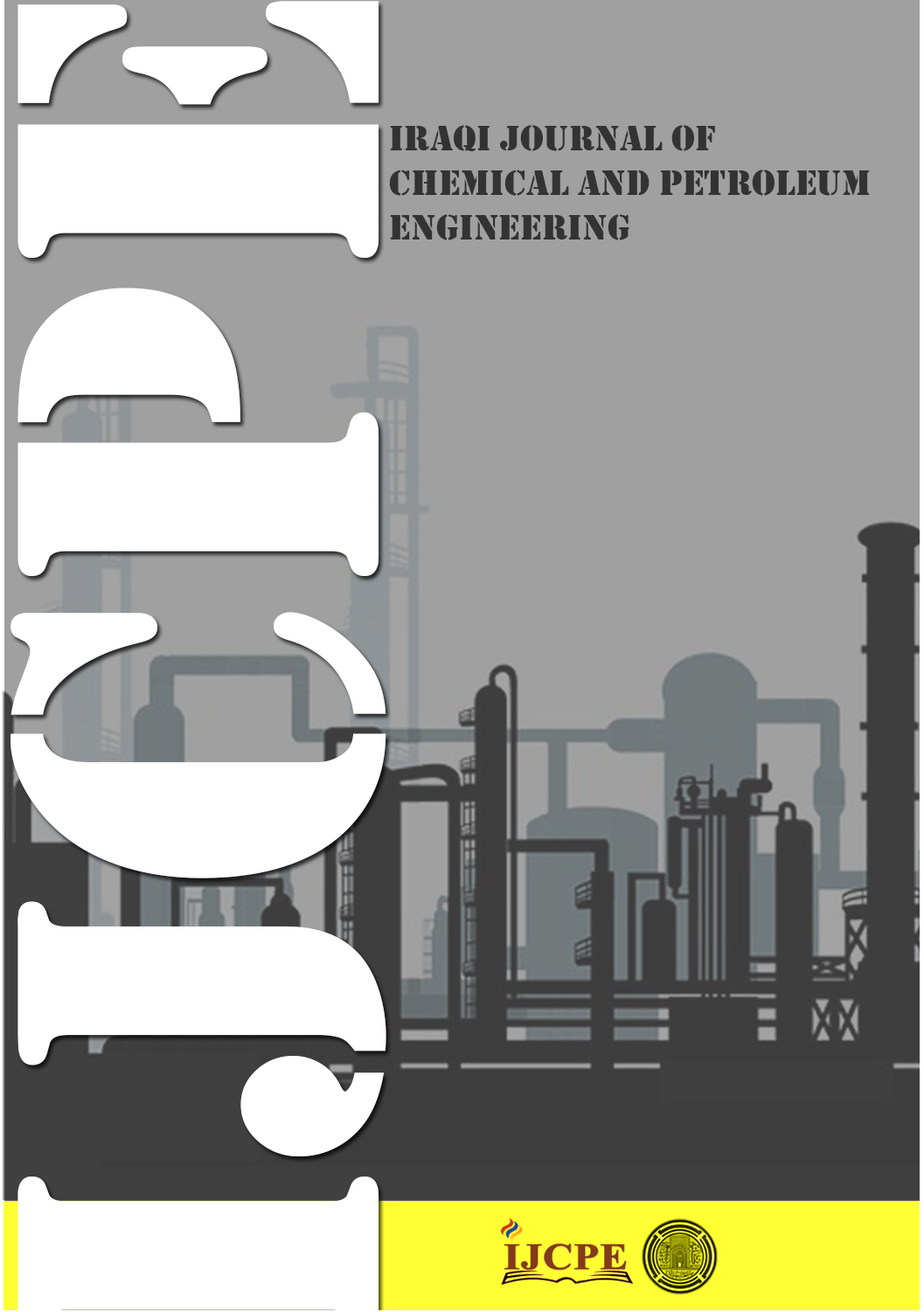Photocatalytic degradation of methylene blue by robust visible-light-driven polyvinylidene fluoride membranes incorporating Ag2O@CRA photocatalyst: Kinetics analysis and cost assessment
DOI:
https://doi.org/10.31699/IJCPE.2025.3.3Keywords:
Kinetics, oxidation; heterojunction photocatalyst; photocatalytic membrane; polyvinylidene fluoride; methylene blueAbstract
The kinetic study of the visible-light-driven photocatalytic degradation of methylene blue (MB) dye by the Ag₂O@CRA heterojunction photocatalyst and robust polyvinylidene fluoride membranes incorporating Ag₂O@CRA heterojunction photocatalyst (PVDF/Ag₂O@CRA) was investigated. This study involves a comparison of the outcomes of the kinetic study performed based on the experimental data of the oxidative photocatalytic degradation of the MB dye. The zero-order, pseudo-first-order, and modified Freundlich kinetic models were applied to accomplish this study. The results showed that the photocatalytic oxidation of the MB dye by the Ag2O@CRA photocatalyst followed the pseudo-first-order kinetic model, and the apparent rate constant (k1) value was 0.1231 min-1. The photocatalytic oxidation of the MB dye by the modified PVDF membrane with 0.3 wt.% Ag2O@CRA photocatalyst followed the pseudo-first-order kinetic model, and the apparent rate constant (k1) value was 0.0196 min-1. Also, the Langmuir-Hinshelwood model was used to model the MB photocatalytic degradation kinetics by the Ag2O@CRA photocatalyst for 10-40 mg/L inlet MB concentrations. Likewise, the Langmuir-Hinshelwood model was used to model the kinetics of the MB photocatalytic degradation by the PVDF membrane with 0.3 wt.% Ag₂O@CRA photocatalyst for 5-20 mg/L inlet MB concentrations. It was found that the intrinsic photocatalysis reaction rate constant (kr) was 0.8286 mg/L.min for the Ag₂O@CRA heterojunction photocatalyst and 0.209 mg/L.min for the PVDF/Ag₂O@CRA photocatalytic membrane. Also, it was found that the equilibrium adsorption constant (Kad.) was 0.3245 L/mg for the Ag₂O@CRA heterojunction photocatalyst and 0.218 L/mg for the PVDF/Ag₂O@CRA photocatalytic membrane. The manufacturing cost for the Ag₂O@CRA photocatalyst and PVDF/Ag₂O@CRA photocatalytic membrane was estimated to be $2.45/10 g and $78/m², respectively.
Received on 31/03/2025
Received in Revised Form on 25/06/2025
Accepted on 26/06/2025
Published on 30/09/2025
References
[1] A.G. Saleem, S.M. Al-Jubouri, S. Al-Batty, M. Wali Hakami, Determination of controlling fouling mechanism using the Hermia models and estimation of the manufacturing costs of the modified polyvinylidene fluoride-based ultrafiltration membranes, Iraqi Journal of Chemical and Petroleum Engineering, 26, 2025, 67–76, https://doi.org/10.31699/IJCPE.2025.1.7
[2] S.M. Al-Jubouri, S.I. Al-Batty, R. Ramsden, J. Tay, S.M. Holmes, Elucidation of the removal of trivalent and divalent heavy metal ions from aqueous solutions using hybrid-porous composite ion-exchangers by nonlinear regression, Desalination and Water Treatment, 236, 2021, 171–181, https://doi.org/10.5004/dwt.2021.27707
[3] S.M. Abbas, S.M. Al-Jubouri, High performance and antifouling zeolite@polyethersulfone/cellulose acetate asymmetric membrane for efficient separation of oily wastewater, Journal of Environmental Chemical Engineering, 12, 2024, 112775. https://doi.org/10.1016/j.jece.2024.112775
[4] A.B. Salman, S.N. Abdulqahar, Electrochemical oxidation of methyl blue dye using stainless steel rotating cylinder anode, Desalination and Water Treatment, 300, 2023, 158–166, https://doi.org/10.5004/dwt.2023.29713
[5] T.J. Al-Musawi, G. McKay, P. Rajiv, N. Mengelizadeh, D. Balarak, Efficient sonophotocatalytic degradation of acid blue 113 dye using a hybrid nanocomposite of CoFe2O4 nanoparticles loaded on multi-walled carbon nanotubes, Journal of Photochemistry and Photobiology A: Chemistry, 424, 2022, 113617, https://doi.org/10.1016/j.jphotochem.2021.113617
[6] T.J. Al-Musawi, P. Rajiv, N. Mengelizadeh, I.A. Mohammed, D. Balarak, Development of sonophotocatalytic process for degradation of acid orange 7 dye by using titanium dioxide nanoparticles/graphene oxide nanocomposite as a catalyst, Journal of Environmental Management, 292, 2021, 112777, https://doi.org/10.1016/j.jenvman.2021.112777
[7] A.B. Salman, R.T. Al-khateeb, S.N. Abdulqahar, Electrochemical removal of crystal violet dye from simulated wastewater by stainless steel rotating cylinder anode: COD reduction and decolorization, Desalination and Water Treatment, 320, 2024, 100787, https://doi.org/10.1016/j.dwt.2024.100787
[8] H. Ben Slama, A. Chenari Bouket, Z. Pourhassan, F.N. Alenezi, A. Silini, H. Cherif-Silini, T. Oszako, L. Luptakova, P. Golińska, L. Belbahri, Diversity of Synthetic Dyes from Textile Industries, Discharge Impacts and Treatment Methods, Applied Sciences, 11, 2021, 6255, https://doi.org/10.3390/app11146255
[9] Z.H. Jabbar, A.A. Okab, B.H. Graimed, M.A. Issa, S.H. Ammar, Photocatalytic destruction of Congo red dye in wastewater using a novel Ag2WO4/Bi2S3 nanocomposite decorated g-C3N4 nanosheet as ternary S-scheme heterojunction: Improving the charge transfer efficiency, Diamond and Related Materials, 133, 2023, 109711, https://doi.org/10.1016/j.diamond.2023.109711
[10] A.G. Saleem, S.M. Al-Jubouri, Efficient Separation of Organic Dyes using Polyvinylidene Fluoride/Polyethylene Glycol-Tin Oxide (PVDF/PEG-SnO2) Nanoparticles Ultrafiltration Membrane, Applied Science and Engineering Progress, 2024, https://doi.org/10.14416/j.asep.2024.08.001
[11] A.M. Elgarahy, K.Z. Elwakeel, S.H. Mohammad, G.A. Elshoubaky, A critical review of biosorption of dyes, heavy metals and metalloids from wastewater as an efficient and green process, Cleaner Engineering and Technology, 4, 2021, 100209, https://doi.org/10.1016/j.clet.2021.100209
[12] N. Nasseh, T.J. Al-Musawi, R. Khosravi, A.H. Panahi, F.S. Arghavan, B. Barikbin, FeNi3@SiO2@CuS magnetic nanocomposite: synthesizing, characterization, and application for methylene blue adsorption, Desalination and Water Treatment, 210, 2021, 402–414, https://doi.org/10.5004/dwt.2021.26456
[13] P.O. Oladoye, T.O. Ajiboye, E.O. Omotola, O.J. Oyewola, Methylene blue dye: Toxicity and potential elimination technology from wastewater, Results in Engineering, 16, 2022, https://doi.org/10.1016/j.rineng.2022.100678
[14] B. Zargar, H. Parham, M. Rezazade, Fast Removal and Recovery of Methylene Blue by Activated Carbon Modified with Magnetic Iron Oxide Nanoparticles, Journal of the Chinese Chemical Society, 58, 2011, 694–699, https://doi.org/10.1002/jccs.201190108
[15] R. Ahmad, R. Kumar, Adsorption studies of hazardous malachite green onto treated ginger waste, Journal of Environmental Management, 91,2010, 1032–1038, https://doi.org/10.1016/j.jenvman.2009.12.016
[16] J. Zhang, Md.S. Azam, C. Shi, J. Huang, B. Yan, Q. Liu, H. Zeng, Poly(acrylic acid) functionalized magnetic graphene oxide nanocomposite for removal of methylene blue, RSC Advances, 5, 2015, 32272–32282, https://doi.org/10.1039/C5RA01815C
[17] A.B. Salman, S.N. Abdulqahar, Electrochemical oxidation of methyl blue dye by stainless steel tubes bundle anode, Desalination and Water Treatment, 317, 2024, 100133, https://doi.org/10.1016/j.dwt.2024.100133
[18] A.B. Salman, Electrochemical oxidation of methyl orange dye by stainless steel rotating cylinder anode, International Journal of Environment and Waste Management, 28, 2021, 114, https://doi.org/10.1504/IJEWM.2021.117012
[19] M.N. Arifin, R. Jusoh, H. Abdullah, N. Ainirazali, H.D. Setiabudi, Recent advances in advanced oxidation processes (AOPs) for the treatment of nitro- and alkyl-phenolic compounds, Environmental Research, 229, 2023, 115936, https://doi.org/10.1016/j.envres.2023.115936
[20] Abdullah, S. M., experimental study for oxidation of phenol by fentons reagent, Journal of Engineering, 16, 2010, 4547–4556, https://doi.org/10.31026/j.eng.2010.01.12
[21] S.M. Al-Jubouri, H.A. Sabbar, E.M. Khudhair, S.H. Ammar, S. Al Batty, S. Yas Khudhair, A.S. Mahdi, Silver oxide-zeolite for removal of an emerging contaminant by simultaneous adsorption-photocatalytic degradation under simulated sunlight irradiation, Journal of Photochemistry and Photobiology A: Chemistry, 442, 2023, 114763, https://doi.org/10.1016/j.jphotochem.2023.114763
[22] A.G. Saleem, S.M. Al-Jubouri, Separation performance of cationic and anionic dyes from water using polyvinylidene fluoride-based ultrafiltration membrane incorporating polyethylene glycol, Desalination and Water Treatment, 319, 2024, https://doi.org/10.1016/j.dwt.2024.100546
[23] S.A. Sadek, S.M. Al-Jubouri, S. Al-Batty, Investigating the Fouling Models of the Microfiltration Mixed Matrix Membranes-Based Oxide Nanoparticles Applied for Oil-in-Water Emulsion Separation, Iraqi Journal of Chemical and Petroleum Engineering, 25, 2024, 1–16, https://doi.org/10.31699/IJCPE.2024.2.1
[24] V. Vaiano, O. Sacco, D. Pisano, D. Sannino, P. Ciambelli, From the design to the development of a continuous fixed bed photoreactor for photocatalytic degradation of organic pollutants in wastewater, Chemical Engineering Science, 137, 2015, 152–160, https://doi.org/10.1016/j.ces.2015.06.023
[25] V. Chakachaka, C. Tshangana, O. Mahlangu, B. Mamba, A. Muleja, Interdependence of Kinetics and Fluid Dynamics in the Design of Photocatalytic Membrane Reactors, Membranes, 12, 2022, 745, https://doi.org/10.3390/membranes12080745
[26] T.V.T. VAN, Chemical reactor design optimization and scaleup, (2008).
[27] A.A. Assadi, J. Palau, A. Bouzaza, D. Wolbert, A.A. Assadi, J. Palau, A. Bouzaza, D. Wolbert, Modeling of a continuous photocatalytic reactor for isovaleraldehyde oxidation: Effect of different operating parameters and chemical degradation pathway, Chemical Engineering Research and Design, 91, 2013, 1307–1316, https://doi.org/10.1016/J.CHERD.2013.02.020
[28] R.K. Sinnott, Chemical Engineering Design: Chemical Engineering Design v.6: Chemical Engineering Design Vol 6, Chemical Engineering Design, 6, 2005, 1056.
[29] M. S.v., B.K. Tripathy, M. Kumar, S. Pramod, Simultaneous degradation of anionic and cationic dyes from multi-dye systems using falling film photoreactor: performance evaluation, kinetic and toxicity analysis, Journal of Environmental Chemical Engineering, 8, 2020, 104486, https://doi.org/10.1016/J.JECE.2020.104486
[30] F. Dalanta, T.D. Kusworo, Synergistic adsorption and photocatalytic properties of AC/TiO2/CeO2 composite for phenol and ammonia–nitrogen compound degradations from petroleum refinery wastewater, Chemical Engineering Journal, 434, 2022, https://doi.org/10.1016/J.CEJ.2022.134687
[31] T.D. Kusworo, A.C. Kumoro, N. Aryanti, T.A. Kurniawan, F. Dalanta, N.H. Alias, Photocatalytic polysulfone membrane incorporated by ZnO-MnO2@SiO2 composite under UV light irradiation for the reliable treatment of natural rubber-laden wastewater, Chemical Engineering Journal, 451, 2023, 138593, https://doi.org/10.1016/J.CEJ.2022.138593
[32] T.D. Kusworo, A.C. Kumoro, N. Aryanti, H. Hasbullah, D.R.S. Chaesarifa, M.D. Fauzan, F. Dalanta, Developing a robust photocatalytic and antifouling performance of PVDF membrane using spinel NiFe2O4/GO photocatalyst for efficient industrial dye wastewater treatment, Journal of Environmental Chemical Engineering, 11, 2023, 109449, https://doi.org/10.1016/j.jece.2023.109449
[33] I. Fatimah, N.I. Prakoso, I. Sahroni, M.M. Musawwa, Y.L. Sim, F. Kooli, O. Muraza, Physicochemical characteristics and photocatalytic performance of TiO2/SiO2 catalyst synthesized using biogenic silica from bamboo leaves, Heliyon, 5, 2019, https://doi.org/10.1016/j.heliyon.2019.e02766
[34] A.S. Adday, S.M. Al-Jubouri, Photocatalytic oxidative removal of the organic pollutant from wastewater using recyclable Ag2O@CRA heterojunction photocatalyst, Case Studies in Chemical and Environmental Engineering, 10, 2024, 100852, https://doi.org/10.1016/J.CSCEE.2024.100852
[35] A.S. Adday, S.M. Al-Jubouri, Developing a versatile visible-light-driven polyvinylidene fluoride/Ag2O@CRA photocatalytic membrane for efficient treatment of organic pollutants-contained wastewater, Journal of Water Process Engineering, 73, 2025, 107713, https://doi.org/10.1016/j.jwpe.2025.107713
[36] E. Erusappan, S. Thiripuranthagan, R. Radhakrishnan, M. Durai, S. Kumaravel, T. Vembuli, N.J. Kaleekkal, Fabrication of mesoporous TiO2/PVDF photocatalytic membranes for efficient photocatalytic degradation of synthetic dyes, Journal of Environmental Chemical Engineering, 9, 2021, 105776, https://doi.org/10.1016/J.JECE.2021.105776
[37] H. Luo, M. Yan, Y. Wu, X. Lin, Y. Yan, Facile synthesis of PVDF photocatalytic membrane based on NCQDs/BiOBr/TiO2 heterojunction for effective removal of tetracycline, Materials Science and Engineering: B, 265, 2021, https://doi.org/10.1016/j.mseb.2020.114996
[38] T.D. Kusworo, A.C. Kumoro, M. Yulfarida, A new visible-light driven photocatalytic PVDF-MoS2@WO3 membrane for clean water recovery from natural rubber wastewater, Journal of Water Process Engineering, 52, 2023, 103522, https://doi.org/10.1016/j.jwpe.2023.103522
[39] D.P. Utomo, T.D. Kusworo, A.C. Kumoro, M.H.D. Othman, Developing a versatile and resilient PVDF/CeO2@GO-COOH photocatalytic membrane for efficient treatment of antibiotic-contaminated wastewater, Journal of Water Process Engineering, 56, 2023, https://doi.org/10.1016/j.jwpe.2023.104353
[40] E.B. Lied, C.F.M. Morejon, R.L. de O. Basso, A.P. Trevisan, P.R.S. Bittencourt, F.L. Fronza, Photocatalytic degradation of H2S in the gas-phase using a continuous flow reactor coated with TiO2-based acrylic paint, Environmental Technology, 40, 2019, 2276–2289, https://doi.org/10.1080/09593330.2018.1440010
[41] N. Ćelić, N. Banić, I. Jagodić, R. Yatskiv, J. Vaniš, G. Štrbac, S. Lukić-Petrović, Eco-Friendly Photoactive Foils Based on ZnO/SnO2-PMMA Nanocomposites with High Reuse Potential, ACS Applied Polymer Materials, 5, 2023, 3792–3800, https://doi.org/10.1021/acsapm.3c00396
[42] A. Azarniya, M. Soltaninejad, M. Zekavat, F. Bakhshandeh, H.R. Madaah Hosseini, C. Amutha, S. Ramakrishna, Application of nanostructured aluminium titanate (Al2TiO5) photocatalyst for removal of organic pollutants from water: Influencing factors and kinetic study, Materials Chemistry and Physics, 256, 2020, https://doi.org/10.1016/j.matchemphys.2020.123740
Downloads
Published
Issue
Section
License
Copyright (c) 2025 The Author(s). Published by College of Engineering, University of Baghdad.

This work is licensed under a Creative Commons Attribution 4.0 International License.













